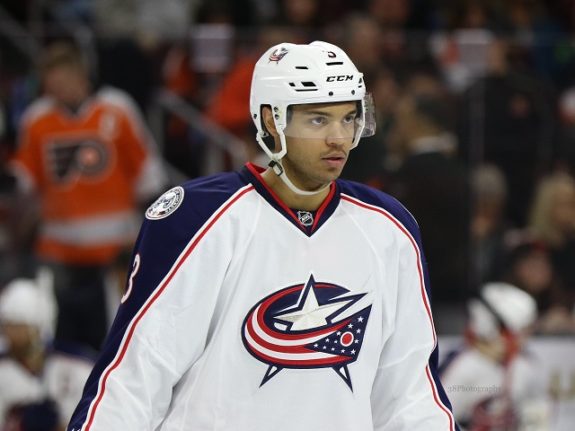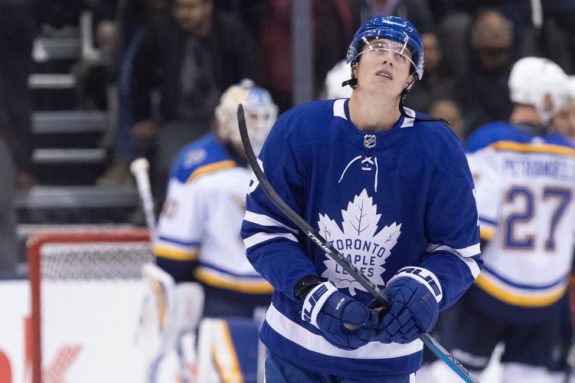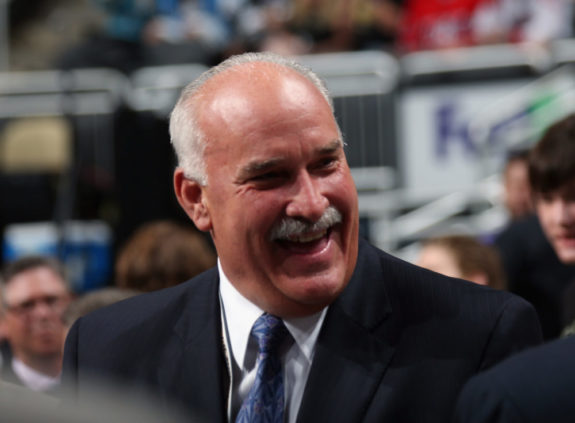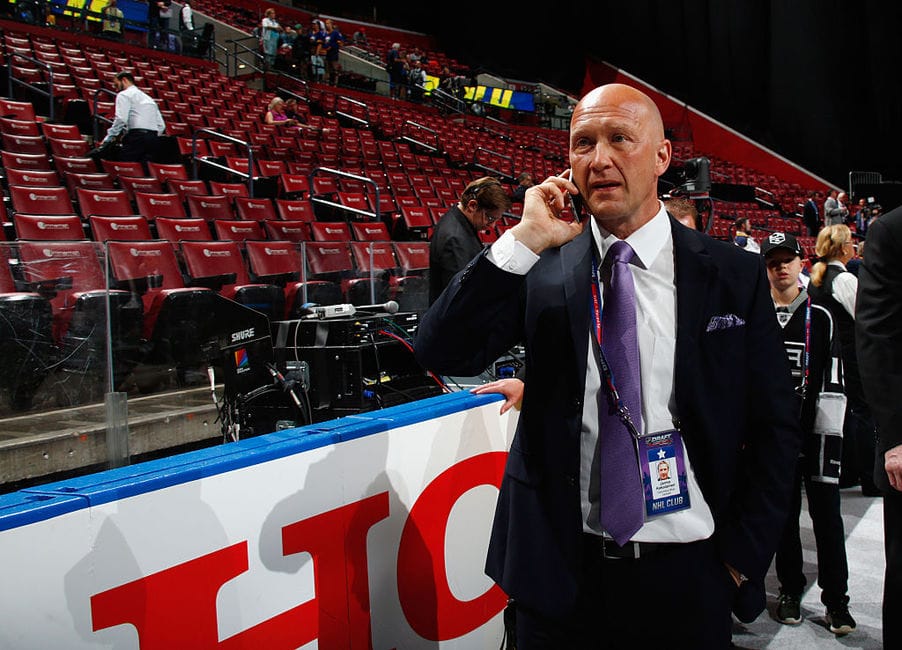You knew it was coming, right? You knew. You hoped it wasn’t, you hoped Seth Jones would commit to the Columbus Blue Jackets long-term and be the next captain, and the Blue Jackets would go back to making the playoffs year after year and everything would go perfectly.
But you knew. We all knew.

When Elliotte Friedman reported that Seth Jones told CBJ brass that he didn’t wish to extend his contract in Columbus and instead wanted to reach free agency, it should not have come as a surprise. But not just because the “woe is us, everyone leaves Columbus, he’s just the next” storyline fans in Columbus were all too prepared for. This just makes sense for the player. I don’t blame him at all. I’m not mad at him.
Jones and management never even got to the point where they were discussing numbers on any potential deal. He never gave them a price range or contract stipulations he had to have, never mandated that he receive the captaincy, none of it. He told them straight off the bat that he isn’t interested in negotiating an extension. That says to me that obviously, this is about one of two things. The first being that he doesn’t like the market or organization, which I doubt. He’s been very complimentary of Columbus, has openly discussed how much he loved playing for former head coach John Tortorella and has been an excellent teammate and leader in the locker room for the last six years.
The more likely reason for Jones leaving Columbus in my mind is option two: he just doesn’t see the Blue Jackets as a competitive team, at least not enough to commit to them long-term. And I agree with him. It’s why this shouldn’t come as a surprise.
Why This Makes Sense for Jones
This will be Jones’ primary contract for his entire career. If he signs a max deal (7 years with any other team), it’ll carry him through his prime years into his mid-30s. If you are locking yourself into a contract that will endure for the majority of the next decade and winning is a — or the — priority, would you sign with the Blue Jackets right now? I wouldn’t. Jones seems like he won’t.
Maybe, if everything were to go right for the next few seasons, the Blue Jackets will be right back where they were as playoff regulars. Maybe, like Alison Lukan details in this excellent article, you can go get a Jack Eichel and a Mitch Marner and be legitimate contenders. Maybe general manager Jarmo Kekäläinen is right, and this is going to be a one-year reload as opposed to a multi-year rebuild. With a flat cap and the Seattle expansion draft bringing a little chaos, there could be ample opportunities to acquire the elite talent needed to win.

But also maybe not – and I’d argue probably not. Eichel will surely get dealt this offseason, and if you can go grab him, great! I already detailed how the Blue Jackets would be fools not to try to trade for him. I don’t think Kyle Dubas and the Toronto Maple Leafs are dumb enough to move Marner, despite a fanbase that has gone absolutely nuclear. Unless Kekäläinen goes and gets multiple elite pieces with term, they’re stuck right where they are right now: not close.
The Blue Jackets are just at the end of their competitive cycle with this current group, and that’s okay. Sure, the fall-off was accelerated by players like Artemi Panarin and Sergei Bobrovsky walking, Pierre-Luc Dubois demanding a trade, and veterans like David Savard and Nick Foligno nearing the end of their deals. But it’s also been augmented by the young prospects like Emil Bemstrom, Gabriel Carlsson, and Alexandre Texier failing thus far to grab major roles like the club hoped, and Jarmo insisted, they would.
It was also expedited by a lack of draft picks. The CBJ forfeited their first-rounder in 2017 to the Vegas Golden Knights in order for them to take David Clarkson’s dead weight contract and not select Joonas Korpisalo or Josh Anderson. They also had only three picks in the entirety of the 2019 Draft – two fourth-rounders and seventh – after going all-in at the 2018 Trade Deadline.
They made the playoffs four years in a row, one of just a few organizations to do so, and were competitive teams every year. But let’s also not act like this was some elite, Cup-level team every season and just couldn’t quite get it done. They lost in the first round three times, and in 2018, the one year where they were truly Stanley Cup contenders, they lost in the second. They pushed the Boston Bruins, the eventual Stanley Cup runners-up, and absolutely could have won that series — maybe even should have. And the sweep of the Tampa Bay Lightning was worth losing those picks. Every organization has to take their shot with the team they believe in at some point, and that was the Jackets’. It was the right call.
But was it a Cup run? Were they this close? Nah. They lost in the second round in six games. And now, the cycle of success for that core has come to a close. This roster is a shell of what it was, and it makes sense that Seth Jones identifies that. And that’s alright! This isn’t a hit piece on the Blue Jackets or an article to convince you that Jones should leave. That was the best stretch of hockey the city of Columbus had ever gotten from its club, and it was so fun. But now it’s time to move forward, and it seems that future will not include Jones.
Look at the top teams in the league we’re watching right now that are playoff regulars and Cup contenders. The Colorado Avalanche have a top-3 player in the world as their top center, two 80+ point wingers alongside him, elite depth on all four lines and four, count them FOUR, Norris Trophy-worthy defensemen on the blue line – plus more top prospects developing. The Tampa Bay Lightning have three 90-point elite players on their top line, including a former MVP and a two-time Rocket Richard winner who was the first overall pick – not to mention arguably the best defenseman and best goalie in the league behind them, surrounded by elite depth.
Vegas is loaded everywhere you look. Carolina has at least one top player at every position and multiple No. 1 defensemen. Washington and Pittsburgh have all-time great players that have elite-level help. Boston’s top line is literally dubbed ‘The Perfection Line.’ Even teams like Dallas, Winnipeg, and Toronto, who all have their issues and have yet to win, have multiple top-of-the-league skill players to build around. The Blue Jackets do not.
Even the teams who have gone through rebuilds recently that will likely be contenders in the next few years, the New York Rangers, Los Angeles Kings, Ottawa Senators and Anaheim Ducks, for instance, are spearheaded by talent that was top-five picks of their respective drafts and are some of the best prospects in the world. Quinton Byfield, Alexis Lafreniere, Kaapo Kakko, Tim Stuetzle, Trevor Zegras, Jamie Drysdale, Alex Turcotte – these are guys the Blue Jackets just do not have right now.
How do you get them? You admit that your cycle at the top is over, and you start again. The top talent that led the way for Columbus the past half-decade is largely gone, but that doesn’t mean they don’t have good pieces in place. Kekäläinen has implored that this will just be a reload to get the team back to where it was, and that’s an admirable goal. Maybe he can pull off some Joe Sakic-esque trades and fleece other NHL GMs for top talent. They don’t have to rebuild.
But they should.
It’s Time to Rebuild, Not Reload
It might feel like the Blue Jackets have done a proper tear-it-all-down rebuild before, but nope. They were unfortunately just that bad for a long time. Largely for the past few years, they’ve been in the dreaded no-mans-land of not quite good enough to win a Stanley Cup, but not quite bad enough to win the NHL draft lottery and land a franchise-changing talent. Here’s the chance.
Here’s management’s opportunity to take one step back so that they can take two steps forward. They re-hired John Davidson, who is one of the best communicators and salesmen the league has seen so that the message between ownership, management and fans can be clear and easy to comprehend. He’s on a five-year contract. Kekäläinen, too, got an extension that keeps the Jackets committed to him until 2025 – I don’t think that’s a coincidence. It gives him time. Before the extension, he insisted this would be a short ‘reload,’ stressing the goal of returning to competitiveness next season. Now this management group has some rope to bypass a rushed process. This doesn’t have to be a tough sell. It doesn’t have to be a brutal, arduous struggle that loses fans. But it has to be thorough, and it has to start now. Here’s why.
A trade shipping Jones out will fetch the CBJ a really nice return. A trade shipping Jones to a team in which he’s expressed a willingness to entertain the idea of a long-term contract will fetch Columbus an absolute haul. An organization that thinks they could be trading for a potential long-term number one right-shot defenseman will pay a fortune. Discuss with him about where he sees himself, what he wants in a team and in an extension, what 10 teams he isn’t at all interested in based on his modified no-trade clause and move forward with the return. If he doesn’t want to discuss an extension with anyone and only wants to reach UFA status in a year and have his pick, then that’s okay; you trade him to the highest bidder. But priority number one must be maximizing your return on Jones.
As I touched on in our season grades for defensemen, it might not be the worst thing in the world to move him anyways, as those in the analytics community will shout from mountaintops. Time will tell, but this is a rare opportunity where the return you receive could be worth the star player leaving.
Outlining the Next Steps
Next, the Blue Jackets have to discuss what teams around the league they think have the best chance of being at the bottom of the standings over the next two or three years. They must accrue draft capital and future assets – they’ve never loaded up on picks to draft high-end prospects. The focus has to be on futures. This upcoming draft, in which Blue Jackets have 3 first-round picks, is not believed to be particularly strong. But it has also been the least-scouted class in decades, so I think they can find some really under-scouted, and therefore, underrated players here that would have gone higher in a normal year. Perhaps they move one of the picks for a roster player or for a chance to move up in the draft.

This is a great first step, and they have to get it right. The last time Kekäläinen and his scouting staff had three first-round picks in a weaker draft was 2013 (his first in Columbus), and they botched it: they bought out their first pick last offseason, and the other two aren’t even in the league anymore. Thankfully there’s been plenty of turnover in the scouting staff since then, but they must get this right.
The next couple of drafts to have blue-chip players that have elite potential, headlined by Connor Bedard, who is all but assured to go first overall in 2023. The Blue Jackets’ prospect system is not highly thought of. We’ve seen from this current crop of prospects they have been waiting on that, even if Kekäläinen insists the club thinks of their young guys more highly than other teams or industry experts do, that’s no guarantee that they’re right and the industry is wrong. The club must as a franchise prioritize drafting high, getting that top-five or top-10 talent through either their own selections or other teams’ via trade, and developing well over the next few seasons. You never know how kids are going to mature and develop, so giving your organization as many shots at the top of the draft is essential.
That brings us to an important caveat in this whole process: they don’t need to sell absolutely everyone and tear their whole franchise down if they don’t want to. They can still retain players they think are more valuable to the future in Columbus than their trade return would be.
That starts with Zach Werenski. Management must begin preliminary discussions with the 23-year-old and see where he views himself long-term. He’s one of the best young defensemen in the NHL and is certainly within the age range to be a pillar on your blue line through a rebuild and beyond. But if he admits that he also can’t commit to Columbus on a long-term deal or likely wants to explore free agency in a few seasons, he’s gone. They must move him, and his return would be arguably larger than Jones’. But Kekäläinen and Davidson have to begin those discussions now.
They also must make their decision on Patrik Laine, as my colleague Mark Scheig discussed. Also 23, Laine has 50-goal, Rocket Richard-winning, game-breaking talent. He is not a player that can do it alone, however, as he has to play with a center who can create time and space for him. He’s a player I’d hold onto and bet on long-term — there’s just so much unique talent there. So few players in the league have the shot he has; I don’t know if I’ve seen a player score from distance more regularly or with more ease than Laine. He’s a guy you can market, something the Blue Jackets desperately need to do better. He can put fans in seats. Plus, if they decide to cut bait and trade him, they are selling on the absolute lowest of low on an asset and deals like that never end well. Just ask the Buffalo Sabres how they’re feeling watching Taylor Hall in Boston right now.

Although our Pete Bauer made his case to hold onto both Joonas Korpisalo and Elvis Merzlikins through the summer and wait to trade one of them, I’m all but certain they will move out one this offseason. I’ve discussed at length why Merzlikins is the better goalie and the player I’d keep, but perhaps they trade him because the return on him would most definitely be higher than a return for Korpisalo. They’ll need to make decisions on other pieces, too: Gus Nyquist, Cam Atkinson, Oliver Bjorkstrand, Max Domi and so on. But you don’t have to move them out if you don’t want to. Atkinson loves Columbus and could be the next captain, a great locker room presence to show young players how to compete every day.
Oliver Bjorkstrand, as my colleague Cody Chalfan analyzed, is one of the most underrated players in the entire league and on an absolute sweetheart deal. I’d be hesitant to move on from him. Perhaps they do move a player or two in that group around trade deadlines when teams in the hunt are looking to add firepower and willing to give up first-round picks. But they don’t have to.
Look at how the Rangers and Kings have executed their rebuilds. They didn’t move out players they saw as core pieces, the Chris Kreiders, Drew Doughtys, Dustin Browns. You need players to show your prospects the ropes and establish the ‘standard’ which Kekäläinen speaks of so often. The next few seasons will be a test – how strong is the culture? You can undergo a full rebuild and turn your club into a true contender, something it has never truly been if you do this correctly. They’d be wise to retain a few key players to lead the way, at least for the time being.
Front Office Attitude Must Change
Now, there is one important issue that this entire idea hinges upon. THW’s Mark Scheig discussed the immediate impact of the Jones news a few days ago, and one of the things he correctly called out is that the Blue Jackets management needs to take a “look in the mirror.” Kekäläinen has deservedly earned a reputation around the league for being difficult to negotiate with, particularly for RFAs and their agents, because he draws a very hard line in the sand and will not cross it, even by a few hundred thousand dollars. I agree with Mark: this is a huge issue, an unnecessary move for the club’s management, and it has rubbed players the wrong way, leading to their eventual departures. It’s something that needs to be addressed and changed internally. For a front office who has spoken ad nauseam of the culture and standard they expect from their players, it certainly seems they have fallen short of it upstairs in Nationwide Arena.
You want players to commit to your organization long-term and ‘want to be Blue Jackets,’ as we hear so often? You draft them, you develop them, you give them their first chance, you treat them well in negotiations, you market them and introduce them to off-ice opportunities in Columbus. You make them feel like valued members of your organization and your community, which is exactly what they are.
That doesn’t mean you bend to their every wish or overpay for players — but there’s no excuse for the pattern of hostile, personal negotiation issues we’ve seen from this management group. It’s impossible to ignore. You cannot tell me that Columbus is a less desirable destination than Winnipeg, or Buffalo, or Detroit, or Calgary, or so many other NHL cities. The difference? Blue Jackets management has insulted too many players with hardline negotiations and hasn’t provided the off-ice benefits that allow players to integrate fully into the market and benefit from their image and likeness.

They drafted and developed Pierre-Luc Dubois, Josh Anderson and Ryan Johansen and traded for Sergei Bobrovsky. They put them all through brutal, personal RFA negotiations that led, directly or indirectly, to their future departures. Johansen called his negotiations “a slap in the face.” It’s not difficult: treat your players better, even when you have all the negotiation power. If you don’t, when they have the power to walk away, they’ll use it – if not earlier.
Now is the perfect time to start this rebuild process. The NHL’s salary cap is expected to stay flat at $81.5 million for the next four or five years, which is going to squeeze some teams into tough situations and force them to make decisions they don’t want to. They will have to move players who are dead weight, and teams like Columbus can charge a premium to pick up their contracts. Also, look at the rest of their division – Pittsburgh and Washington are going to push for another two or three seasons for Stanley Cups, before Alex Ovechkin, Sidney Crosby, Evgeni Malkin, Nicklas Backstrom and the like age out of their window. The Philadelphia Flyers’ core is all over 30, as are many of the New York Islanders. You get a head start on those teams by starting your rebuild now.
If the Blue Jackets are really committed to becoming Stanley Cup contenders, this is where it starts. Tampa, Colorado, Vegas, Carolina, Washington, St. Louis, Pittsburgh, all the teams that have won or come close over the past few years, aside from expansion Vegas, were comprised of elite, top-end, homegrown talent. It doesn’t have to be a terribly long process, it doesn’t have to be painful, it doesn’t have to walk current Blue Jackets to the end of their deals, and it doesn’t force everyone out of town. But it’s time this management group is honest with themselves and the fans and starts to build for the future. Otherwise, they’ll continue to be stuck in the middle.